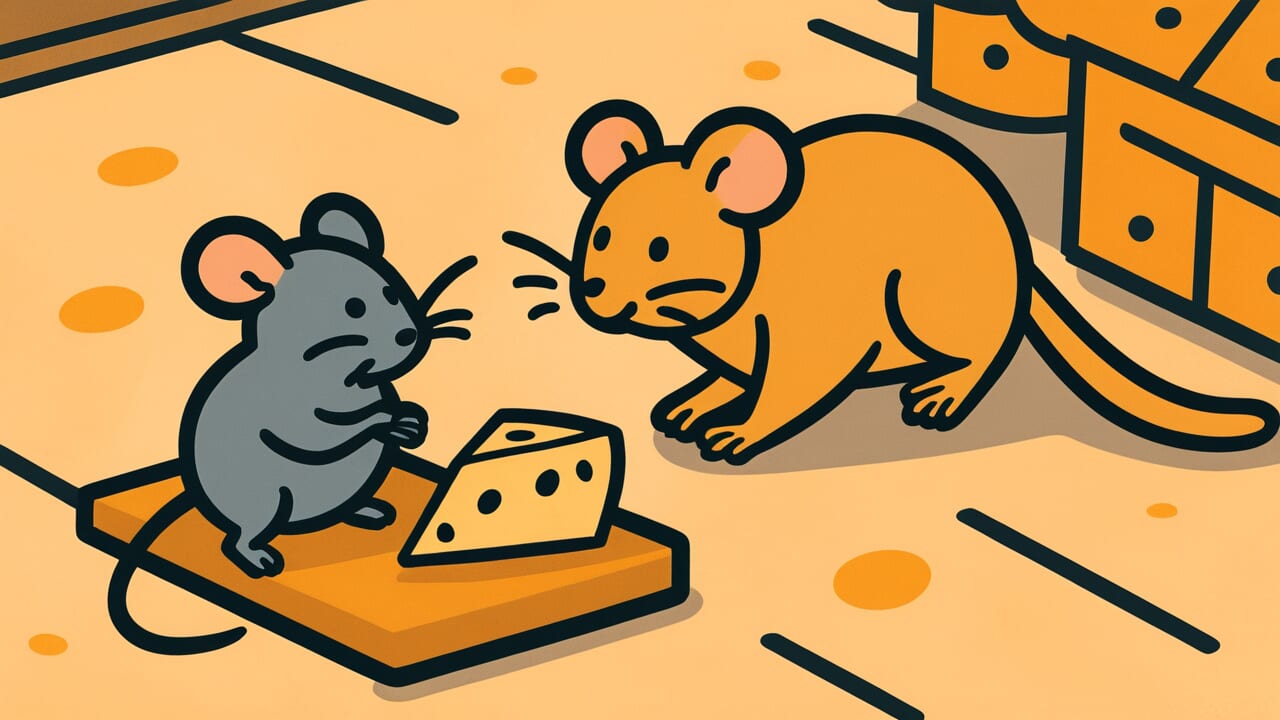How to Read “the second mouse gets the cheese”
The second mouse gets the cheese
[thuh SEK-uhnd mows gets thuh cheez]
All words use standard pronunciation.
Meaning of “the second mouse gets the cheese”
Simply put, this proverb means that being patient and learning from others’ mistakes often leads to better results than rushing in first.
The saying creates a picture of two mice trying to get cheese from a mousetrap. The first mouse rushes in eagerly and gets caught by the trap. The second mouse waits, watches what happens, then safely takes the cheese from the now-triggered trap. This shows how the cautious mouse benefits from the first mouse’s mistake.
We use this wisdom when talking about business, relationships, and daily decisions. Someone might say this when a friend wants to rush into something risky. It applies when new products come out and early buyers face problems. The saying reminds us that waiting can be smarter than being first.
What’s interesting about this wisdom is how it challenges our usual thinking about success. Most people believe being first gives you the best advantage. This proverb suggests the opposite can be true. Sometimes the real winner is the person who learns from watching others fail first.
Origin and Etymology
The exact origin of this proverb is unknown, though it appears to be a relatively modern saying. Most sources suggest it emerged in the 20th century as a business and investment principle. The phrase gained popularity through word of mouth rather than appearing in classical literature.
The saying reflects a time when people began studying business strategies more carefully. During periods of rapid change and innovation, observers noticed that early adopters often faced unexpected problems. Meanwhile, those who waited could avoid these pitfalls and succeed more easily.
The proverb spread through business communities and eventually entered everyday conversation. It became popular because people could easily relate to the mouse and cheese image. The simple story made a complex business concept easy to remember and share with others.
Interesting Facts
The word “mouse” comes from an ancient word meaning “to steal,” which fits perfectly with the proverb’s meaning about taking advantage of opportunities. Mousetraps have been used for thousands of years, making this imagery familiar across many cultures. The proverb uses a simple cause-and-effect structure that makes it easy to remember and repeat.
Usage Examples
- Manager to employee: “Let them launch their risky new product first and see how customers react – the second mouse gets the cheese.”
- Friend to friend: “Don’t rush into that investment everyone’s talking about – the second mouse gets the cheese.”
Universal Wisdom
This proverb reveals a fundamental tension in human nature between our desire for immediate rewards and our need for survival. Throughout history, humans have faced the challenge of balancing opportunity with risk. Those who rushed toward every appealing prospect often faced danger, while those who observed and waited could learn from others’ experiences.
The wisdom taps into our deep understanding of social learning, one of humanity’s greatest advantages. Unlike other animals that must learn everything through personal trial and error, humans can watch others and absorb their lessons. This ability to learn vicariously has helped our species survive and thrive. The proverb reminds us that this patient approach often works better than individual boldness.
What makes this saying universally relevant is how it addresses the cost of being a pioneer. Every generation discovers that breaking new ground comes with unexpected challenges. The first person to try something new bears all the risks and costs of experimentation. Meanwhile, those who follow can benefit from this hard-won knowledge without paying the same price. This pattern appears everywhere from technology adoption to relationship choices, making the mouse metaphor timelessly applicable.
When AI Hears This
Modern businesses prove this proverb’s hidden economic wisdom daily. Companies spend millions researching new markets and products. Smart competitors watch these pioneers carefully. They let others pay the discovery costs first. Then they enter with better information and lower risks. This isn’t copying – it’s strategic resource management. The second player often wins bigger profits.
Humans celebrate first movers but miss the math behind success. We admire bold leaders who charge ahead into unknown territory. Yet data shows second entrants frequently outperform the pioneers. The first mouse pays for everyone’s education about the trap. Smart players use this free information to their advantage. Society calls this following, but it’s actually superior planning.
This behavior reveals remarkable human intelligence hiding behind apparent caution. What looks like hesitation is often calculated strategy in disguise. Humans instinctively understand that watching others fail teaches valuable lessons. The second mouse isn’t slower or more fearful than the first. It’s simply better at managing risk versus reward ratios. Sometimes the smartest move is letting someone else go first.
Lessons for Today
Living with this wisdom means developing the patience to observe before acting, especially when stakes are high. This doesn’t mean avoiding all risks or never being first at anything. Instead, it means recognizing when caution serves you better than speed. The key is learning to distinguish between opportunities where being first matters and situations where being smart matters more.
In relationships and social situations, this wisdom helps us avoid repeating others’ obvious mistakes. When friends rush into decisions that seem problematic, we can learn from their experiences without judgment. At work, watching how new policies or changes affect early adopters can guide our own responses. The challenge lies in balancing this cautious approach with the need to take action when opportunities arise.
The deeper lesson involves understanding that success often comes from preparation and timing rather than pure courage. This perspective can reduce the pressure to always be first or fastest. Instead of feeling left behind when others rush ahead, we can feel confident in our patient approach. The wisdom encourages us to value learning and strategic thinking as much as bold action, creating a more sustainable path to achieving our goals.



Comments